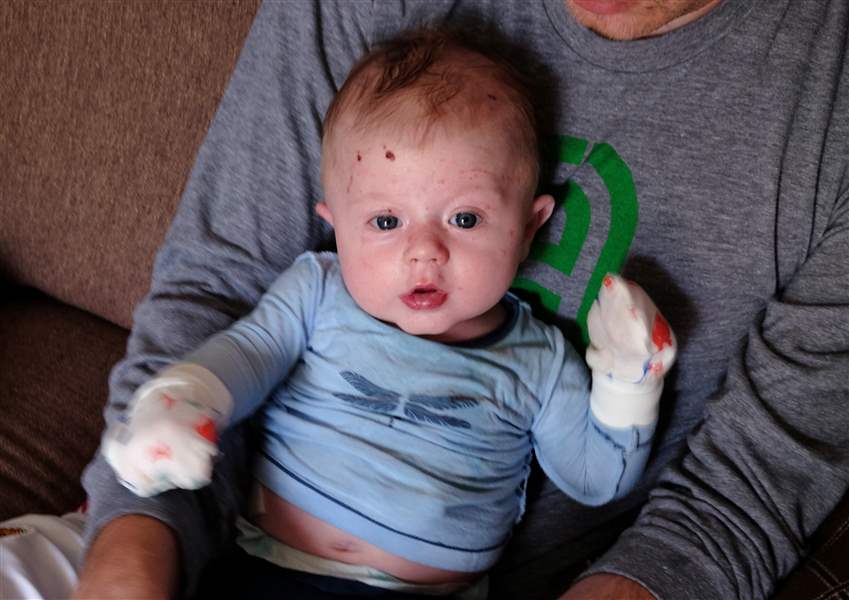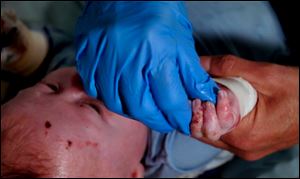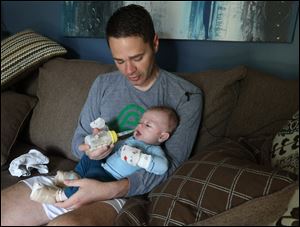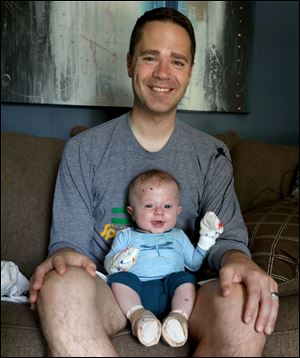
Life with Archer: Local family rallies around son with rare disease
5/9/2018
Archer Brazeau, a three-month-old who was born with a rare skin condition called Epidermolysis Bullosa.
The Blade/Lori King
Buy This Image
In a place where they never expected to be, dealing with something they had never heard of, time had a funny way of moving for the Brazeau family.
There were moments in the neonatal intensive care unit at Mott Children’s Hospital at the University of Michigan when Kirk and Nicki Brazeau felt as if they lived an entire lifetime. Then there were entire days that went by in what seemed like minutes. It was a whirlwind of people, appointments, tears, laughs, tests, well-wishes, research, and community support with a few blinks of sleep in between.

The hands of Archer Brazeau, a three-month-old who was born with a rare skin condition called Epidermolysis Bullosa, is oiled to help reduce blisters. Epidermolysis Bullosa causes skin to suffer severe burns with even the smallest amount of friction, so his hands and feet are wrapped to protect them.
This is life with Archer.
When Archer Brazeau was born Jan. 19, his entrance in the world had been about as simple as can be. Their pregnancy was worry-free and a four-hour delivery yielded an 8-pound, 3-ounce baby boy. For five hours, everything was normal enough, though his blood sugar was a touch low.
After a routine test with a needle, Archer’s heel reacted instantly with a severe blister, and the medical team grew concerned.
Near midnight, Kirk and Nicki heard a diagnosis of a disease they didn’t know existed hours earlier: Epidermolysis Bullosa, a rare genetic skin disease in which the layers of the skin do not bond. Any friction causes blistering, severe burns, and scarring. The risk of infection is constant. The Dystrophic Epidermolysis Bullosa Research Association of America (DEBRA) calls it “the worst disease you’ve never heard of.”
“We had literally no idea what it was,” said Kirk, a youth soccer coach for Toledo Celtics. “Then five hours later, you have to start asking the hard questions. ‘Is this curable?’ No. ‘Is this treatable?’ No.”
VIDEO: Kirk Brazeau talks about caring for his son Archer
After 35 consecutive days of care at UM, Archer returned to the family’s Old Orchard home. It is a challenge every moment of every day, and Kirk knows it sounds crazy when he says this, but he promises: There are blessings involved, too. The Brazeau family is not sulking and not asking why.
“You’re never going to know why. We can talk about the scientific why, but this is life,” Kirk said. “This is what we were dealt with. This is his battle.”
‘Once in a career’
Archer’s specific diagnosis is Recessive Dystrophic Epidermolysis Bullosa (RDEB), which affects about 6 kids per 1 million births in the U.S. His subtype is fatal before the age of 30 in more than 70 percent of cases.
Dr. Johann Gudjonsson, who is a professor of skin molecular immunology at Michigan and helped treat Archer, said most parents are unfamiliar with the disease until it is diagnosed in their child.

Archer Brazeau, a three-month-old who was born with a rare skin condition called Epidermolysis Bullosa.
“It’s so uncommon that people won’t come across it during their day-to-day living, and even physicians that are out in the community may have never seen it,” Dr. Gudjonsson said.
Gene testing showed Archer has a severe case, though there have been recent medical breakthroughs regarding EB.
In research that was published in Nature in November, 2017, doctors were able to use stem cells to create genetically modified skin for a 7-year-old boy with junctional EB. The boy arrived to a German hospital very near death in 2015, and out of options, doctors contacted Italian doctor Michele De Luca, who harvested small cell samples from the boy’s unaffected skin, which were modified so the mutated gene was no longer present, then used to grow new skin. Over the course of three surgeries, doctors covered nearly 80 percent of the boy’s body with the lab-grown skin — and the epidermis adhered to the dermis underneath, saving the boy’s life and almost completely ridding him of the disease’s symptoms.
Until regulators approve similar approaches for widespread use, however, the only answer for EB is maintenance. Even for many physicians, treating EB is a completely new challenge.
Just in case, the Brazeaus travel with a 17-page informational packet on Archer’s care to give to medical personnel.
“Our pediatrician, when he saw him for a wellness check up, told us that this is a once-in-a-career thing you see as a doctor,” Kirk said. “This is something you read about in a book and then never see.”
Life at home
Everything about Archer’s care requires preparedness and some sort of specialization. Nicki and Kirk’s oldest son, Anderson, is the portrait of a normal 3-year-old. For Archer, even the basic baby care requires extra steps.

Kirk Brazeau feeds his infant Archer, his three-month-old who was born with a rare skin condition called Epidermolysis Bullosa. Epidermolysis Bullosa causes skin to suffer severe burns with even the smallest amount of friction.
“It is [different], especially because we have a kid like Anderson, where everything went as planned,” Nicki said. “Everything is five steps harder than it was with Anderson. Even a diaper change is different, and we can’t feed him the same way.”
The family cannot use a traditional bottle (or a pacifier) because the friction causes blistering on Archer’s lips and inside his mouth. They use a pigeon bottle, which drips milk into Archer’s mouth, and a gastrostomy tube allows for him to be continuously fed at night. Feeding, always a worry with EB-affliction children, has been an early success for Archer, who is up to 12 pounds, 6 ounces, well within the normal range for his age.
The couple had a full rotation of baby clothes from its oldest son, but they’re still sitting in a box in their basement. Archer likely never will be able to eat solid foods, and teething presents a new challenge because RDEB patients cannot use a traditional toothbrush.
EB patients continuously lose moisture, so the temperature in the house must be watched vigilantly, and any blistering has to be dealt with quickly and properly to prevent infection.
DEBRA provided a care kit to the family, and the house has an arsenal of medical supplies. A perforated, silicone-based second skin goes over blisters; there are topical ointments, antibiotics, and enough Vaseline to last a lifetime; transfer wraps and a elasticated bandage called Tubifast to keep wounds compressed; and Archer’s hands and feet always are covered in sacrum pads.
Further, he needs a regular cocktail of various pain medicines to keep him relatively comfortable.
“It’s all stuff that you never, ever, ever, ever thought you would need,” Kirk said.
Changing diapers is like playing a game of Operation, the ultimate goal of which is to get Archer through the process with as little pain as possible. In the NICU, Archer was constantly covered in Vaseline, which Kirk joked made it like holding a turkey.

Kirk Brazeau with his infant Archer Brazeau, his three-month-old who was born with a rare skin condition called Epidermolysis Bullosa.
Overall, the time at home has added a measure of normalcy. Though he can’t hold them, the parents recently introduced Archer to Anderson’s toys, and he’s accustomed to the family’s three dogs. He sleeps in his own room, away from the sterility of medical facilities.
“It’s been really good for him,” Kirk said.
Community steps up
The family has been blown away by the support received from many different places. People who Kirk and Nicki have not spoken to in a decade sent well-wishes. Soccer programs, from local rivals to international clubs, reached out to Kirk. Legendary UM football player Charles Woodson called Archer “a little champion” on Twitter.
DEBRA has been in touch from the beginning, and the community is bigger and more connected than most expect. Later this summer, Kirk will travel to Phoenix for a national conference on the disease.
Locally, the Toledo Celtics have offered their help in many ways. Kirk, who was the National Soccer Coaches Association of America’s 2017 boys coach of the year as the Celtics’ coaching director, has traveled all over the U.S. with his various teams.
The club put on a fund-raiser to help put a dent in the family’s medical costs, which already are approaching $300,000, and his Under-18 boys team chose to put Archer’s initials on their jerseys this season.
“Kirk’s mostly a mentor to us. He’s always teaching us about life as he teaches us the correct way to play soccer, so I think that’s the best part about him,” said Josh Kidder, a captain of the team. “Whenever we’ve ever needed anything, he’s always there, so we figured we had to be there for him at his toughest time.”
The club has a recent history of winning and of being a major player in its region.
But Jeff Upton, whose son, Scott, plays on the U-18 team, said most families involved with Celtics chose the program because of the direction their children receive.
“We’re not there because of the winning tradition,” Upton said. “We’re there because of what Kirk stands for, what the club stands for, and what he’s done for the kids. He’s more than just a coach, and if you interviewed 20 parents, they’d all say the same thing.”
As worrisome as Archer’s condition has been, Kirk said the past three-plus months have allowed the family to see the good in people.
While EB is serious, constant, and the root cause of an unknown future, Kirk doesn’t hesitate to tell everyone who asks that Archer will be OK.
There’s a unique little boy in their house, and he’s tough.
So yes, he promises. This is a blessing.
“He’s more inspirational than anything I’ve heard, seen, or been around,” Kirk said. “As much as Nicki and I want to worry, he steers the ship. Even though he can’t say it, you just know it when he looks at you.
“ ‘We got this, and we can do this together.’ ”
Contact Nicholas Piotrowicz at npiotrowicz@theblade.com, 419-724-6110 or on Twitter @NickPiotrowicz